Lakhs of migrant workers walking back to their home states on national highways is probably the biggest humanitarian crisis in India for a long time. But what is the issue of migrant workers? How many such migrant workers are there? What have the governments done for them?
On 24March 2020, Prime Minister Narendra Modi announced a complete nation-wide lockdown in an effort to contain the spread of COVID-19. The initial idea was to impose a lockdown for a period of 21 days, which in due course was extended 3 more times, with the current 4th phase of lockdown extending until 31May 2020.
The lockdown effectively meant all commercial activities except those dealing in essential services have been restricted i.e most of the businesses, factories, trade, construction activities etc. have come to a halt. The lockdown also included the ban on travel i.e road transport, trains as well as air travel. The current phase of lockdown saw considerable easing of restrictions in most areas and commercial activity has restarted. However, the severe restrictions in the initial phases meant that migrants working in the unorganized sector across the country started walking long distances in the hope of reaching their home states.
In fact, within few days of the imposition of the lockdown, news reports started emerging of the migrant workers especially, those in the unorganized sector travelling by foot or by hitchhiking to go back to their native places.
Loss of Income & Uncertain future – major causes for the plight of migrant workers
Migrant workers are among the most affected section of the society due to the lockdown measures. The prevailing situation of the migrant workers is a result of many factors.
Majority of the migrant workers are daily wage labourers or other contract workers whose income is reliant on availability of work. Majority of these workers are employed in the Construction and Manufacturing industry while others are employed across the unorganized sector.
The country-wide lockdown resulted in temporary closure of all economic & industrial activity. This meant non-availability of work for these migrant workers and hence no source of income. Without major savings, majority of these migrant workers are facing a situation of potential starvation without work.
Apart from lack of food, housing is also a cause for concern. These migrant workers come from rural areas and live in cities for work. They do not have any permanent residence and are put up in temporary accommodation near construction sites or factories. Closure of activity also meant that many of them had no shelter.
An uncertain future is another important factor that has driven many of them on the walk back home. With no credible information on the re-opening of the economy, many of them want to be back with their families.
Facing the aforementioned challenges, migrant workers consider returning back to their native place as a safer option for survival rather than staying back in the cities.
The closure of public transport added to the woes of the migrant workers, forcing them to take the journey back home by walk, personal transport or by hitchhiking on the way.
The United Nations Human Rights Commission has expressed concern about the plight of migrant workers in India in the wake of the lockdown.

In the status report submitted by the Central Government to the Supreme Court, it has stated that the migrant workers were apprehensive about their survival and moved due to the panic created by fake news that the lockdown would extend for a longer period of time. The court expressed its satisfaction with the responses provided by the government.

Ambiguity on the number of Migrant Workers
Over the last two months, migrant workers have been travelling from various states back to their native places, especially to Uttar Pradesh, Bihar, West Bengal & Jharkhand. Even now, as India enters the last few days of Lockdown 4.0, the reverse migration is still going on unabated as per reports coming from various parts of the country.
However, there is no clarity on number of such migrants in India, for the central and the respective state governments to effectively plan for relief measures.
Although India has passed a legislation four decades ago to safeguard and regulate the condition of service of Inter-state labourers through the ‘The Inter-state Migrant Workmen (Regulation of Employment and Conditions of Service) Act,1979’, there is no centralized database yet as far as migrant workers is concerned.
Responding to a question in Lok Sabha on 23 March 2020, the Minister for Labour and Employment stated that there is no register maintained with details of migrants, and further emphasized that in view of the dynamic nature of the workforce, it is not feasible to maintain any such database.
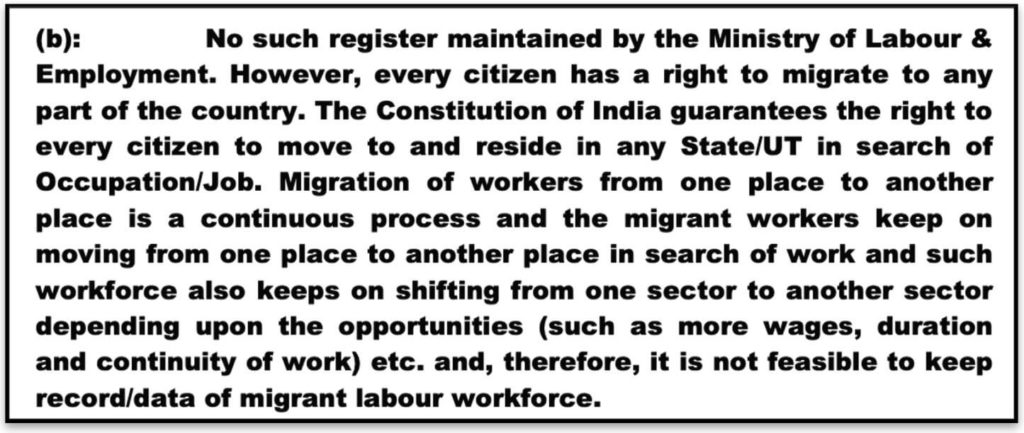
Further in this response and also in response to another question, the ministry has estimated the size of the migrant workforce at over 10 crores as of 2016. This was based on an extrapolation of the workforce as per 2011 census and pegging the share of migrant workforce at 20% of the total workforce.

While this is an estimation of the workforce, the total inter-state migrant population as per 2011 census is 5.42 crores.
In the case of Labour Ministry data, it counts the entire workforce who are working in a place other than their native place. This data includes professionals, employees and others apart from the migrant labourers and those migrants who migrated within a state. The census data on the other hand is about the total inter-state migrant population and is not just the workforce.
Since the current crisis is specific to migrant labourers working in the unorganized sector, no reliable estimates are available about their number.
As per a report of World Economic Forum, which based its numbers on 2011 census, there are around 13.9 crore internal migrants within the country (both inter-state and intra-state migrants). The report further stated that Uttar Pradesh and Bihar are the largest source states followed by Madhya Pradesh, Punjab, Rajasthan, Uttarakhand, Jammu & Kashmir and West Bengal. Most of the migrants reported Delhi, Maharashtra, Tamil Nadu, Gujarat, Andhra Pradesh, Telangana, Karnataka and Kerala as the destination states.
As per the status report submitted by Central Government to the Supreme Court of India regarding government’s response to COVID-19, around 4.14 crore people have migrated to other states for work. Further, the government has roughly estimated the number of people travelling barefoot across India due to the lockdown as 5-6 lakhs.
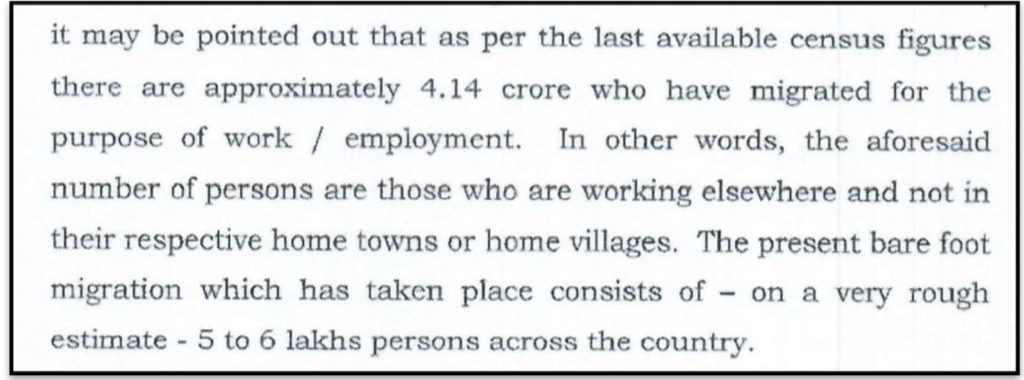
Provision of relief camps among the initial actions taken by Central Government
The initial response of the Central government in the wake of the emerging migrant worker crisis was focused on directing the states and employers to provide relief to the migrant workers.
The MHA issued certain directions on 29March 2020 to restrict the movement and provide relief. Among other things, the directions included the following.
- States/UTs to provide shelter and food to migrant workers and needy within their respective areas, so that they follow lockdown measures.
- For those who have already started to their home states, shelter and food to be provided in the nearest relief camp setup by the states.
- All the employers to pay wages to the workers without any deductions.
- Landlords not to demand rent from the workers (including migrants) for a period of one month. Action to be taken against landlords who force the workers to vacate.
What about Transport?
In spite of these directions by the Central government and action taken by some states to mitigate the problems of the workers, the movement of the migrant workers to their home states did not stop. Many are still walking on the roads and using other personal means of transport to reach their homes.
After these developments, the State governments and the Centre have made special travel arrangements for the migrants to return back to their home states.
As per an update provided by MHA on 25May 2020, more than 44 lakh migrants have travelled in more than 3,274 Shramik Special trains to reach their respective home state. IRCTC has also updated stating that more than 74 lakh free meals and over 1 crore water bottles were provided to the migrants. Furthermore, around 40 lakh migrants travelled in buses to reach their home state.
The National Migrant Information System (NMIS)
On 16May 2020, the Central Government has announced the launch of National Migrant Information System. It is an online database created by National Disaster Management Authority (NDMA) and aids in streamlining the movement of migrant workers.
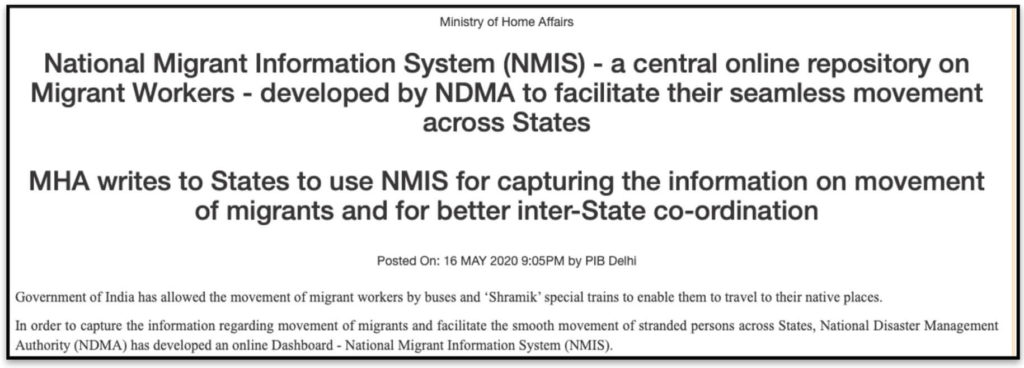
What was part of the initial relief package?
On 26March 2020, the Centre had announced its first major COVID-19 relief package. Although there was no specific relief allocation done for the migrant workers, there were cash transfers and steps for food security announced for the poor of which migrants were considered to be a part.
Furthermore, Centre has approved the advance release of Rs. 11,092 crores to all the states under States Disaster Risk Management Fund (SDRMF), a part of which can be spent on food and shelter for homeless people including migrants who were stranded due to lockdown.
Supreme Court takes cognizance of the plight of Migrant workers
During the earlier days of lockdown, hearing a PIL filed in the Supreme Court on behalf of the migrant workers, a Bench headed by Chief Justice SA Bobde, has stated that:
- Court cannot interfere in the policy decisions of the government
- No payment of money to migrant workers is required since they are receiving food at shelter homes.
Supreme court also quashed another PIL, which sought directions to District Magistrates to identify, provide shelter & free food and transport to the migrant workers already on the move. The court observed that it was the responsibility of the respective State governments.
However, recently on 26May 2020, the Supreme court took suo-moto cognizance of the issues of migrant labour and directed the Centre and the State to immediately provide adequate food, shelter and transport to the migrant workers who are stranded.

Apart from this direction, the court has issued notices to Centre and State Governments to submit their responses urgently and stated that the next hearing would take place on 28 May 2020.
Free Food Grains & increased allocation to MGNREGS – Centre’s relief to Migrants
Addressing the nation on 12May 2020 , Prime Minister Narendra Modi announced that the government has come up with a comprehensive relief package of Rs. 20 Lakh Crores. Following this, Finance Minister Nirmala Sitharaman announced the details of the package over the next few days.
The First Tranche of Economic Relief package was announced on 13May 2020. However, there was no mention of relief to the migrant workers.
Relief to migrant workers was addressed in the Second Tranche of Economic Relief Package announced on 14May 2020. This package included providing free food grains as well as an affordable housing rental scheme. ‘One Nation, One Ration Card’ scheme was also announced which provides migrants their quota of PDS irrespective of the state that they are currently in.
On 17 May 2020, the Fifth and Final Tranche of Economic Relief package was announced. Under this an additional allocation of Rs. 40,000 crores was announced for MGNREGS to provide returning migrants with work in their native states.
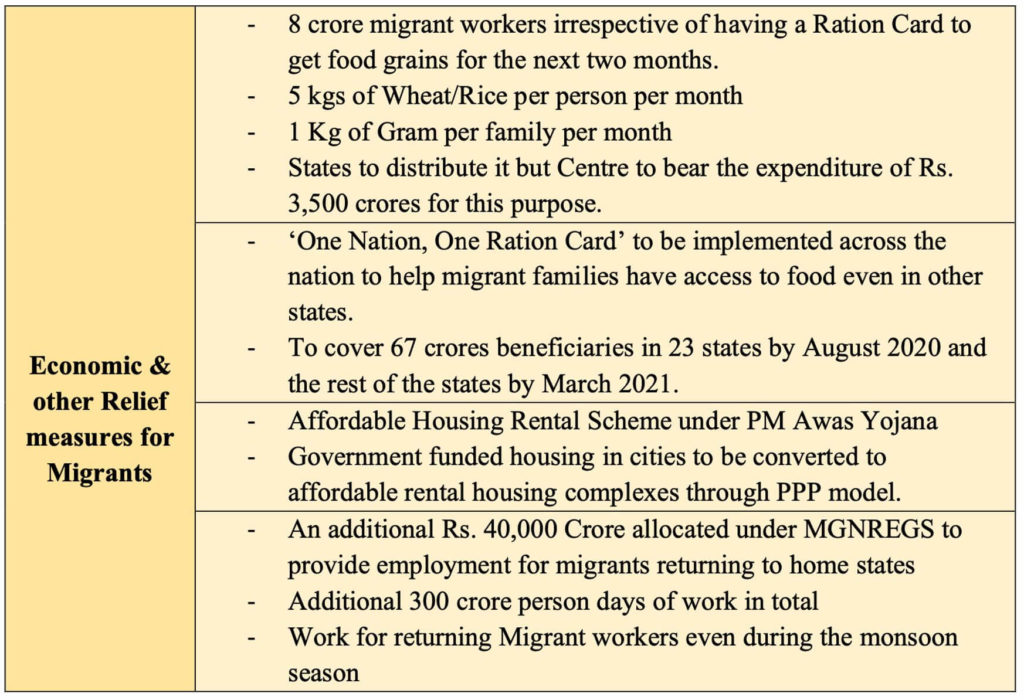
On 20 May 2020, the Cabinet approved food grain relief to the migrant workers, announced earlier by the Finance Minister. The total expenditure incurred by the Government of India towards this is Rs. 3,109.52 crore which includes food subsidy to the tune of Rs. 2,982.27 crore and expenditure towards inter-state transportation and others to up to Rs. 127.25 crores. As highlighted earlier, 8 crore migrants stand to benefit from this food relief.
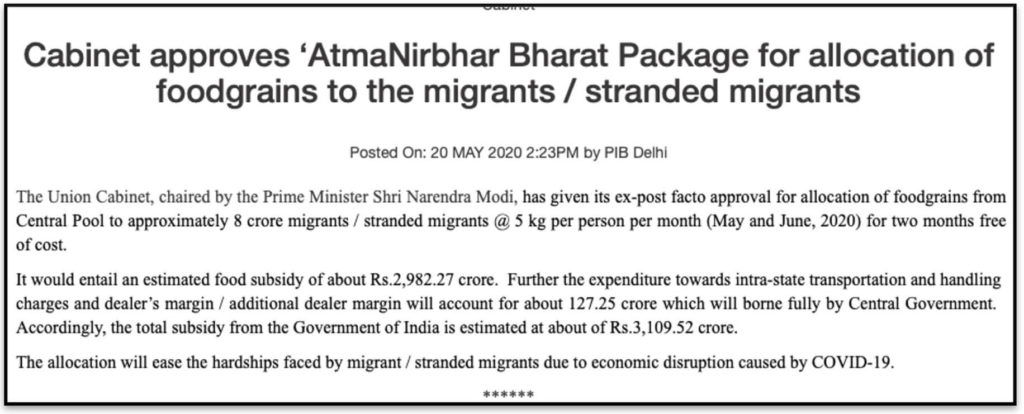
More efforts needed to assuage the pain of Migrant workers
As per government’s announcement on 25 May 2020, than 44 lakh migrants traveled by train and another 40 lakh migrants used bus to reach their home states. However, reports of migrants walking on highways or hitchhiking on their way still continue. The extent of migrants who are still on the roads and stranded on their way home has not yet been ascertained.
Meanwhile there have been multiple reports of tragic incidents about the migrant workers and families who have lost their lives on their journey back home, through accidents as well as exhaustion. Apart from these tragic incidents, there are reports of migrant workers allegedly having died of hunger on shramik special trains. There are also reports of route diversions of these special trains resulting in migrants reaching their home states after a delay of many days.
Furthermore, different means of providing transportation and permissions by states have also added on to the woes of the migrants.
While the reverse migration of the migrant workers has morphed into a humanitarian crisis, solutions to larger questions on their future & livelihoods are yet to be figured out. The solutions have to be found amidst the chaos of the COVID-19 crisis.
In-spite of the efforts of respective state governments, center, NGOs and other members of civil society, many migrants are still seen on the roads underscoring the need for more coordinated efforts.
Featured Image: Migrant Workers issue


